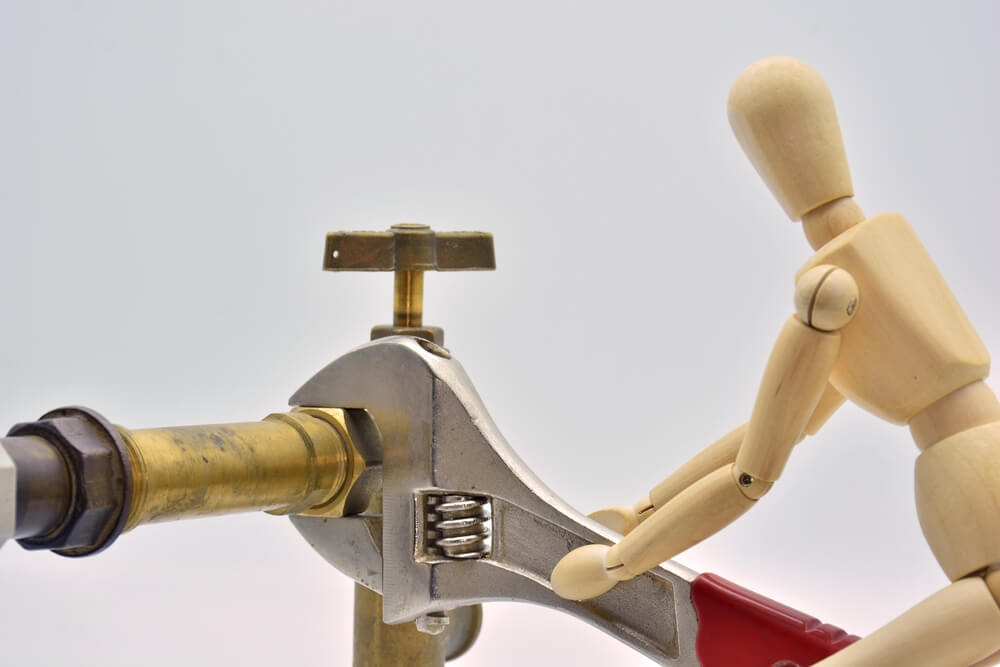If you can understand the basic principles of nature, you can understand plumbing fixes. Think about gravity, pressure, and water and how the three interact to make your toilet flush, tub fill up, and faucet run. You don’t have to be an Anthony PHC plumber to get these concepts. In fact, we’ll even teach you how to repair some of your own plumbing problems!
Subsystems and Shutoff Valves
Two subsystems make up the plumbing system in your home: one that brings fresh water in and the other that takes waste water out. Since the water entering your home is under pressure, it can travel upstairs and around corners. When water enters your house, it passes through a meter that keeps tabs on how much water you’re using.
You can usually find your main water shutoff valve towards the exterior of the house nearest the street, which is normally near the water meter. This is where your cold water line comes in from the municipal city. Your main water shut-off valve should be quickly closed in a plumbing emergency to prevent flooding. Most fixtures have individual stop valves, so you don’t have to shut off your entire water supply when the emergency is only with a sink, shower, or toilet.
Water Heaters
 Your cold water supply is immediately ready for you, but the hot water has to go through the water heater first. One pipe carries the cold water to a water heater. From there, a hot water line moves the heated water to the fixtures and appliances that require hot water.
Your cold water supply is immediately ready for you, but the hot water has to go through the water heater first. One pipe carries the cold water to a water heater. From there, a hot water line moves the heated water to the fixtures and appliances that require hot water.
Cold water goes into the water heater, and hot water comes out of the water heater. The water heater is not connected to toilets or other plumbing fixtures that only need cold water, though some smart toilets have their own on-demand water heaters.
The easiest way to find the hot water pipeline, which is separate from your cold water pipeline, is to locate your water heater and follow the pipe from there. To identify your hot and cold water lines, the knobs and levers on the hot water line are usually colored red, while the cold water line knobs and levers are colored blue. One energy-saving tip is to insulate your hot water pipelines to keep the heat from escaping.
The thermostat on the heater adjusts the device’s heating elements to keep your water at the desired temperature. The default temperature for a home water heater is 120 degrees Fahrenheit.
Dishwashers might require water at a higher temperature, but they normally have water heaters included that boost the temperature another 20 degrees Fahrenheit after getting the 120-degree water from your water heater. Anthony PHC plumbers have the expertise to install and repair water heaters, since amateurs should steer clear of trying to fix these systems themselves.
Drainage Systems and Vents
Drainage systems differ from supply systems in that they do not depend on pressure. Waste matter exits the house, because the drainage pipes angle downward. That way, gravity does all the work.
Eventually, these pipes filter into a sewage treatment facility or septic tank. Vents, traps, and cleanouts all contribute to making this process possible. Vents poke up from the roof of your house to allow air to enter the drainpipes and avoid creating pressure differentials. Without an air supply coming in from the vents to replace the water that no longer occupies that space, the wastewater would have to be siphoned away.
Trap in the Nastiness

Just as important as the vents are traps, also called P-traps, because they look like a sideways “P.” It’s the curved or S-shape section of the pipe under the drain and is seen under most sinks. From there, the water flows from the basin with enough force to go through the trap and through the drainpipe.
However, there’s enough water that sticks around in the trap afterward to create a seal preventing sewer gas from seeping into your home. You need a trap in every fixture. Toilets are unique because they’re self-trapped, meaning they don’t require an additional trap at the drain. Think about all the hair and dirt that goes down your shower drain—this is regulated by drum traps. These guys form a seal against sewer gas and collect the nastiness to prevent blockage.
Unblocking a Trap
If you need to unblock a trap, there are some simple steps you can follow to combat this common predicament. You’ll need a bowl, bucket, old toothbrush, and replacement washers for this fix.
The first step is to undo the sink trap. Then, position the bowl beneath it to catch any water. Remove whatever’s creating the blockage and wash the trap in clean water. Use the toothbrush for thorough cleaning. Go ahead and replace worn washers while the trap is disassembled.
Replace the trap, and you’re good to go! The drain, waste, and vent are all necessary for things to run smoothly in your plumbing, so it’s imperative that all parts are regularly maintained.
Fixtures
A bridge between the water supply and drainage system (two completely separate systems) is called a fixture. Examples of fixtures would be toilets, sinks, washing machines, and outside faucets. If something draws freshwater and discharges wastewater, it fits this category. The great thing about fixtures is that some of them have individual shutoff valves, so you don’t have to close the main shutoff for repairs.
Do-It-Yourself Repairs
If you decide to change or add any pipes in your home, make sure that you have approval from your local plumbing code official (some things are prohibited). Before starting the repair process, turn off the water supply to the fixture or main shutoff. These do-it-yourself repairs cover only minor repair issues, so be sure to contact a professional Anthony PHC plumber if you have a legitimate plumbing problem in Kansas City.
Unclogging Sink Drains
For unclogging sink drains, you’ll only need a drain plug and adjustment arm. These clogs normally happen near the pop-up assembly of the drain. First, remove the spring tab from the drain plug adjustment arm. Then, remove the ball valve from the sink trap and the pop-up plug. Clear out the debris clogging the sink and enjoy your fully functioning sink drain.
Unclogging Toilets
It’s embarrassing at times (and always seems to happen at the worst possible moment), but luckily, a clogged toilet is usually something you can take care of without the aid of a plumber.

You can tell a toilet’s trap or drain is blocked when water rises to the rim and drains slowly after being flushed. The first step is to try to loosen the blockage with a plunger. If that doesn’t work, use a snake to burrow into the blockage. Pull a portion of the snake out of the drum.
Then, tighten the retaining nut on top of the snake’s body. Finally, rotate the drum of the snake so it burrows into the waste system to clear up the blockage. After that, your toilet should flush like a dream!
Fixing Water Pressure in the Shower
To increase the water pressure in your shower, use a descaling product to remove limescale buildup. You’ll need a screwdriver, bowl, and descaling solution for this project. First, unscrew the shower head from the hose.
Then, unscrew the spray plate and put it in a descaling solution (make sure it’s completely immersed). Leave the spray plate in the solution for a while (this time varies), and flush any remaining scale from the pipes prior to replacing the shower head. If the water pressure continues to be a problem, contact an Anthony PHC plumber to see whether the issue may be more serious.
Sewage
Sewage, or wastewater, is the stuff that gets washed down the sink and flushed down the toilet. It can’t be dumped outside your house because it (1) creates a terrible smell, (2) contains harmful bacteria (like E. coli), and (3) has suspended solids and chemicals that have a negative effect on the environment.
The environmental impacts include excessive algae growth due to nitrogen and phosphate from the wastewater, oxygen consumption that kills fish, and suspended solids that make it difficult for fish to see (and makes the water look gross).
Septic Tanks
Many homes have private sewage treatment in the form of septic tanks. This is normally necessary for houses that are very spread out from their neighbors in more rural areas. Septic tanks are essentially big concrete or steel tanks buried underground, normally in the back or front yard, that can hold 1,000 gallons of water. Water flows into the tank at one end and leaves the tank at the other end.
The water within the septic tank is normally divided into three layers: the scum layer at the top (anything that floats), sludge layer at the bottom (anything heavier than water), and the middle (relatively clear water layer). The water contains nitrogen and phosphorus, natural fertilizers.
The septic tank produces smelly gases, so sinks have P-traps. These loops of pipe hold water in the lower loop and block gases from being released into the house. Instead of flowing into your home, the gases move up the vent pipe (seen poking through house roofs).
Drain Fields
When new water enters the septic tank, the water that was already inside gets pushed out into a drain field. The drain field is composed of perforated pipes buried in trenches filled with gravel.
Drain pipes are typically four inches in diameter and are buried within trenches that measure four to six feet deep and two feet wide.
The bottom layer of the trench (two to three feet) is filled with gravel. This layer of gravel is covered in dirt. The water is then absorbed and filtered in the drain field. Depending on the ground material, you may have to have a larger drain field. For example, since hard clay absorbs water slowly, you need a bigger surface area to compensate.
All you need to power a septic tank is gravity, so this passive system shouldn’t rack up the power and electricity bill. As a bonus, the grass over your septic tank will be grainer because the soil absorbs the moisture and nutrients from the drain field. An Anthony PHC plumber can go into greater detail about the pros and cons of investing in a septic tank.
Anthony PHC has a lot of great information on keeping your home safe, comfortable, and energy efficient. You can learn how to drain house water lines to winterize your plumbing, how to check your sump pump, and much more!
If you need extra help or information, an Anthony PHC plumber will know the exact steps necessary to get your plumbing back on track. Contact us today if you need fast service and experienced professionals in Kansas City or the surrounding areas.

